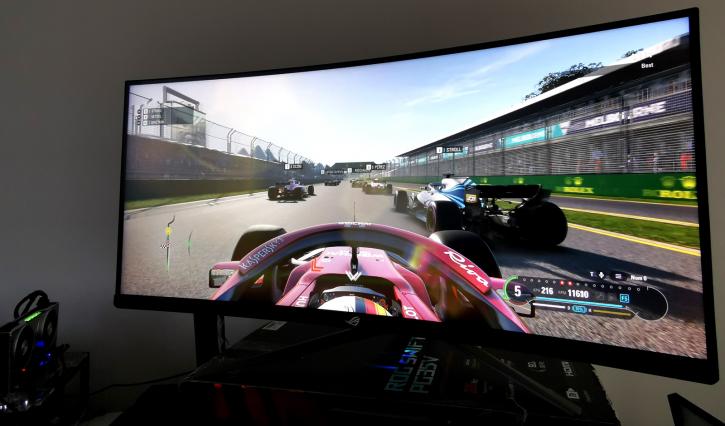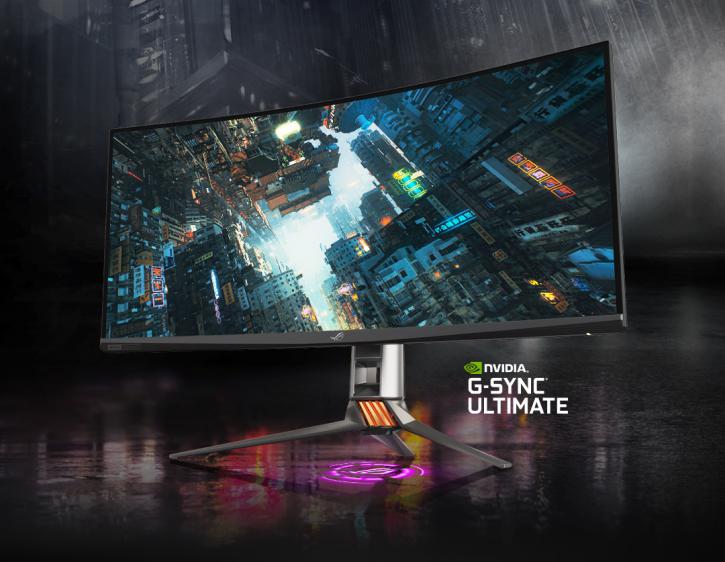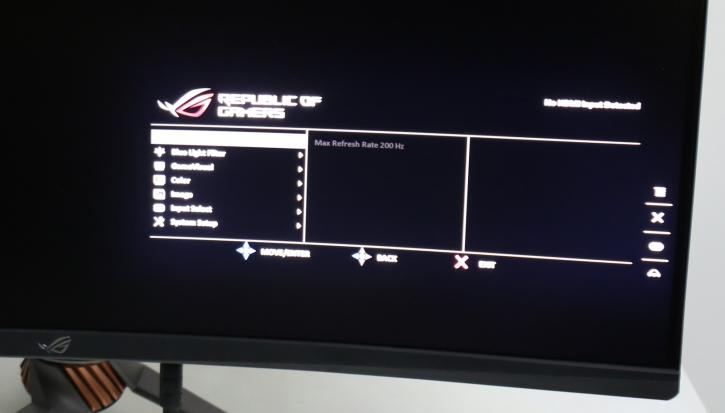Local Dimming Zones - HDR - Color precision
The RoG Swift PG35VQ
ASUS press release - ASUS Republic of Gamers (ROG) announced that the ROG Swift PG35VQ gaming monitor is now available. Featuring a 35-inch UWQHD (3440 x 1440) resolution HDR panel with a 21:9 aspect ratio, overclockable 200Hz refresh rate and 4ms response time, ROG Swift PG35VQ is an ultra-wide display. With full array local dimming (FALD) LED backlighting that’s dynamically controlled across 512 zones, a peak brightness of 1,000 nits in each zone with DisplayHDR 1000 certification and NVIDIA G-SYNC Ultimate technology, ROG Swift PG35VQ delivers nuanced and realistic scenes with detailed shadows and highlights stunning contrast, cinematic colour, and low latency to deliver the best HDR gaming experiences. In addition to its advanced panel, ROG Swift PG35VQ comes with Smart Fan Control, a ROG-exclusive feature that ensures optimised cooling and whisper-quiet operation by dynamically controlling the fan speed based on thermal requirements. The monitor also features a foolproof VESA mounting kit, ASUS Aura Sync for harmonised, system-wide lighting effects and a hi-fi-grade ESS 9118 digital-to-analogue converter (DAC) for exceptional gaming audio.
- Panel size (diagonal): 35" 3440x1440 (88.9 cm) wide screen (21:9)
- Panel backlight / type: Direct-type LED / VA
- Colour saturation: DCI-P3 90%
- Refresh rate: 200Hz
- Brightness: 500 cd/m2 (typical/SDR on) 750 cd/m2 (typical/HDR on) 1,000 cd/m2 (peak/HDR on)
- Contrast ratio: 2500:1 (typical/SDR on) 500,000:1 (typical/HDR on)
- Display colours: 1.07b (10 bit with dithering)
- Response time: 4ms (Gray to Gray)
- HDR (high dynamic range): Yes, DisplayHDR 1000 certified support
- Dynamic local dimming: Yes, 512 Zones
- Input / output: DisplayPort 1.4, HDMI v2.0
- Earphone Jack: 3.5mm earphone jack
- Dimensions: 833 x (449~549) x 306 mm
- Special features: NVIDIA® G-SYNC Ultimate technology, Flicker Free technology
- Low Blue Light (Blue Light Filter), ASUS Aura Sync technology, Hi-Fi-grade ESS ES9118 DAC built-in, ambient light sensor, Smart Fan Control technology
- Weight: 13.5 kg (Net), 20.4kg (gross)
LEDs are responsible for more than just the backlighting; the ROG Swift PG35VQ has integrated RGB illumination that’s part of our Aura Sync ecosystem.
Panel and color precision
The panel (native AUO) makes use of Quantum-dot technology, combined with a VA panel that offers brighter imagery, really bright actually. With support for cinema-standard DCI-P3 color gamut, it retrieves a 25% wider color range than sRGB, resulting in more realistic color reproduction. Obviously, your one mandatory requirement for G-Sync is that you need a modern (and fast) GeForce based graphics card, starting with GeForce Series 10, we'd advise something like a GTX 1080 / RTX 2070 Super or better to get your HDR groove going on at Ultra HD. The display offers an advertised 4ms response time (GtG). Color gamut tagged at 90% (DCI-P3) and 99% for Adobe RGB. The monitor we'll review today is a 35-inch version and measures 833 mm x (449~549) mm x 306 mm.
The looks - RGB and LEDs
From an aesthetic appearance, this monitor just ticks all the right boxes for the true RoG gamer fanbase. The design is lovely to look at from a visual perspective, mostly due to its size but also due to its RoG styling. It's a sturdy product as well, and it sits on your desktop like a serious piece of kit. Of course, in the year 2019 everything is embedded with RGB lighting. On the back side, you'll spot a massive RoG logo, that is RGB lit and controllable with Aura SYNC, so you can match up the animations and colors with the rest of your (compatible) RGB eco-system.
HDR on the RoG Swift PG35VQ
The HDR implementation on this monitor is out of this world. Playing HDR games like Destiny 2, Battlefield V, Far Cry New Dawn, FF15 and Formula 1 2018 exhibited a level of clarity which is not something that is easily described in a review. Seeing it in a real-world environment, in the end, is what will be the convincing factor. The monitor is both VESA DisplayHDR 1000 and Ultra HD Premium certified to ensure a proper HDR viewing experience. My advice, go to a store, watch HDR and let yourself be convinced. It's more than dynamic colors, retina soaring whites. You'll notice it in game with fires, car headlights, the sun or moon. It is just awesome to watch, however, for some it can also be a bit too much as, at 1000 Nits, trust me - it's a lot of brightness.
Multi-Zone Local Dimming and HDR
Over the years we have seen many LCD technologies in relation to backlighting. Traditional lighting methods simply are not sufficient anymore when using HDR as the peak brightness (a bright LED) can and will cause side effects. If you just have a backlit LCD screen or edge LED lighting then the tremendous amount of brightness for HDR will create a lot of blooming. This is also referred to as 'inhomogeneous backlighting', it is one of the LCD technology's fundamental problems. Please have a look at the example photo below:
Above, you can see that blooming effect, you may as well call it a halo. With an edge-lit screen, the LEDs light up portions of the screen they shouldn't and, as such, light 'bleeds' out a bit. OLED solved that as each pixel is controlled and lit by itself, it does not use any form of LED (back/edge) lighting. That's also why black is black on OLED, pure black simply means turning the pixel off, creating excellent deep contrast levels. However, OLED as a technology is never going to make it into gaming monitors, as OLED panels can suffer from screen burning and, with our Windows 10 enabled static desktop screens, that is ill-advised. While still not as optimal as OLED, the industry now is and has been adopting a new technology called 'Full-Array Local Dimming'. A methodology that is very similar to the way LCD TVs were configured back in the day, but instead of using the CCFL backlight, now it uses LED backlights instead. The term‚ 'full-array' means that there are LED zones spread out over the entire backside of the LCD panel. And here technology is advancing, in combination with Quantum-dot LCD screens and lots of arrays of back side LEDs. The big advantage is that the panel can light up just that portion of the screen that needs to be lit, keeping other places in the scene on screen as off, and thus totally dark. That creates deep contrast levels and peak brightness where needed. This technology is advancing fast and rapidly to UHD/HDR televisions and monitors. Full-Array Local Dimming has now made its way to gaming PC monitors, and quite frankly we feel it is the future of HDR panels for gaming monitors. We recently tested the Samsung C32HG70, which has Full Array Local Dimming, however with just 8 zones.
The ASUS ROG Swift PG35VQ, however, has a proper 512 local dimming zones.
Blacks are black in the dimming zones that are not lit, however, if you focus on the OSD spot, you can see a bit of an aura. It is minimal though and not something you can see with normal scenery.







